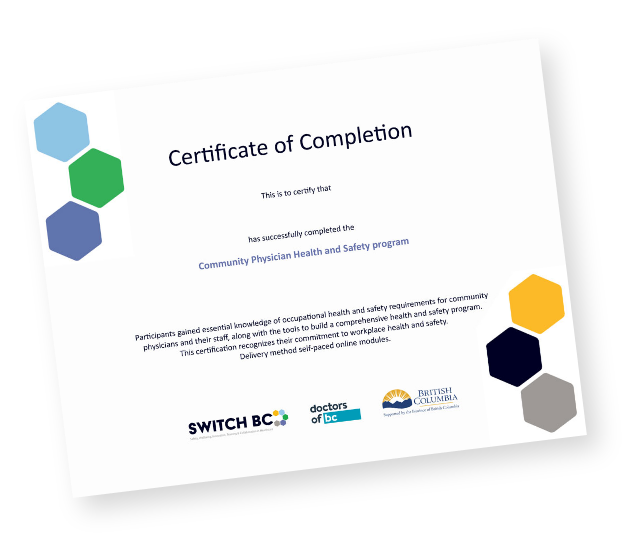Site Conditions, Storage, and Postings

Site Conditions
-
Review Eating Area Requirements
Employers must provide a clean, safe space for workers to store and eat food, separate from areas with potential contamination risks. A suitable eating area should be physically separated from any source of contamination, such as labs, exam rooms, or other spaces with biological hazards. WorkSafeBC recommends this space ideally be at least 5.6m² in size.
-
Review Washroom Requirements
Employers must ensure that a sufficient number of plumbed washroom facilities are readily available for workers. A single washroom shared by staff and the public, or reliance on the building’s shared public washrooms, is adequate if the facilities are clean, sanitary, well-stocked, and in proper working order.
-
Review Asbestos and Lead Exposures Before Renovations
If your clinic undergoes renovations or demolition and there is a chance that workers could be exposed to harmful levels of asbestos and lead, a formal risk assessment must be performed by a qualified person. If asbestos and lead are found during the assessment, an exposure control plan must be created for each. If abatement is needed, it must be done by a certified contractor. Asbestos and lead are commonly found in buildings built before 1990.
-
Review Stairway Requirements
Stairways with more than four steps and a width greater than 112 cm (44 in) must have continuous handrails on both sides. If they don’t, contact your landlord to have it corrected.
Storage and Housekeeping
-
Review Biological Hazards Storage Requirements
Biological hazards must be stored in a designated, clearly marked area that is well-ventilated, well-lit, and separated from occupied spaces such as lunchrooms or change rooms. Biohazards include any materials contaminated with biological agents (e.g., bacteria, viruses) or toxins that may cause adverse health effects, such as clinical specimens and used sharps.
-
Review Chemical Hazards Storage Requirements
Chemical hazards must be stored according to their Safety Data Sheet (SDS) instructions. In most cases, they should be kept in tightly closed containers, in a cool, dry, and well-ventilated area away from electrical panels, HVAC systems, or hot water tanks. Chemical hazards are chemical agents that can cause adverse health effects, such as eye or skin irritation (e.g., cleaning and disinfecting).
-
Review Pressurized Cylinder Storage Requirements
Cylinders containing pressurized substances (e.g., oxygen, liquid nitrogen) must be protected from sparks, flames, excessive heat, and physical damage. They must also be secured, using trolleys, wall-mounted chains, or straps, to prevent falling or rolling.
-
Review Tripping hazards
Employers must ensure all floors, stairs, and are maintained in good repair and kept free of slipping and tripping hazards. Inspect flooring regularly, especially in high-traffic areas, to ensure it remains flat and free of trip hazards. Keep passageways clear of boxes and loose items and replace or repair any damaged carpeting.
-
Review Storing Requirements to Prevent Accidents
All materials that could fall from above and potentially injure a worker should be secured to prevent accidents and reduce the risk of injury. Store supplies in cabinets, supply rooms, or low-level shelving rather than on high closet shelves, and place heavy items at the bottom of shelves.
-
Review Electrical Equipment Safety Requirements
Passageways around electrical equipment must remain clear to ensure authorized staff can access all parts quickly, especially in emergencies such as a short circuit or fire. Do not place boxes or tables in front of the electrical panel, and keep flammable materials, such as alcohol-based chemicals, organic solvents (e.g. paint), or batteries, away from electrical equipment.
-
Review Emergency Exit Requirements
Emergency exits must be planned and marked to allow quick, unobstructed evacuation. Exit doors must stay clearly identified, and the routes leading to them must be kept free of obstruction at all times. Do not place boxes, bicycles, or any other items on exit pathways that could block evacuation.
Required Postings
-
Review Posting Requirements
Employers are legally required to post certain documentation and signage to protect workers’ health and safety. These postings should be placed in visible areas so workers can easily access them:
- The WorkSafeBC Notice to Workers (see below), which outlines injury prevention, reporting procedures, and compensation claims.
- A Notice to Workers (see below) indicating where workers can access the Occupational Health and Safety (OHS) Regulation in their workplace. Employers must make a copy of the Workers Compensation Act and OHS Regulation available (e.g., as PDFs on a clinic computer) and post a notice in the workplace stating where workers can review them.
- Workplace First Aid Procedures, detailing available resources, locations, contacts, attendant duties and authority, reporting responsibilities, transportation arrangements, and prearranged emergency routes. View and print the SWITCH BC First Aid Procedures Poster.
- Signs or placards clearly marking areas in the clinic where biological hazards (e.g., clinical specimens, contaminated sharp boxes) are stored. Example: “BIOHAZARD – Clinical Specimens” or WHMIS Biohazard pictogram.
- Names and work locations of all joint health and safety committee (JOHSC) members, and the three most recent JOHSC meeting reports (if the clinic is required to have a JOHSC).


